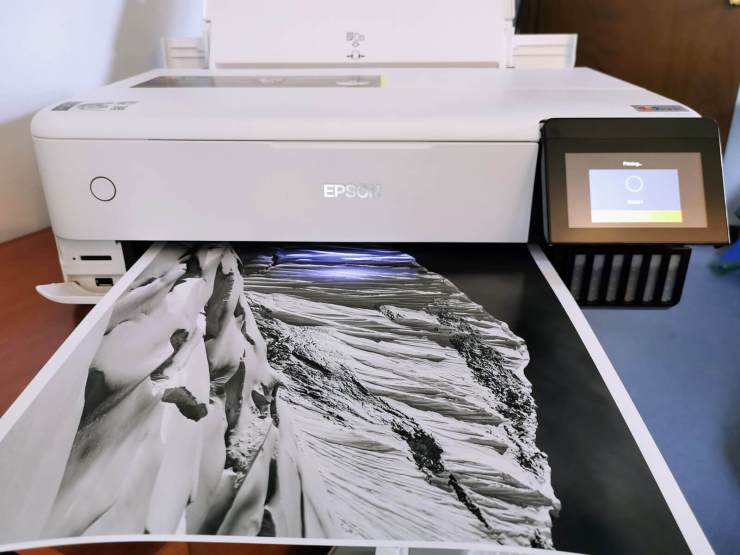Having more options when selecting photo paper is great, but it can also get confusing. Here’s how to select the right paper based on the photo you plan to print and display.
E-surface paper
E-surface paper — also called luster, satin, pearl, and sometimes semi-gloss — is a premium finish on heavier paper. It’s normally the number one choice for photographers. It boasts accurate color, realistic saturation, excellent neutral flesh reproduction, and great intensity. E-surface paper offers brighter blues, cyans, purples, and reds with a finger-resistant finish.
This paper has a repeating texture that looks like the surface of an orange. This texture hides minor scratches and scuffs from wear and handling and has a lower direct reflection of light to the viewer. This makes for less glare or shine and makes the image easier to see from all angles. Standard Archival Value of 100 years in home display; 200 years in dark storage.
Metallic paper
The metallic paper uses a combination of film and laminate layers resulting in striking three-dimensional images. It has a rich distinctive metallic look, making the image almost appear to be printed on a sheet of metal. It offers natural-looking flesh tones, sharp details, and beautifully saturated colors.
Although normally more expensive, a metallic finish can provide a vibrant “pop” to images and it’s resistant to tearing and curling without any additional lamination, making it a truly unique keepsake. Standard Archival Value of 100 years in home display; 200 years in dark storage.

Glossy
Glossy paper has a shiny finish, making prints appear brighter with more vibrant colors. They look fancy and convey a high-quality feeling. On the downside, glossy print’s “shiny” attribute can be a problem when photos are viewed using intense light sources such as daylight sun or strong light bulbs. Light reflected from the photo print can blind the viewer, making it hard to see the photo.
Glossy paper is also more likely to attract dust and fingerprints and is thus more likely to get dirty over time. Standard Archival Value of 100 years in home display; 200 years in dark storage.
Matte
Matte paper is a smooth photographic paper that gives your images a unique warmth and fine art feel. It’s excellent for displaying photos that must be displayed “naked” (not behind plastic/glass) in an environment where light reflections can be an issue. The colors have a more muted feel to them. This can be used to great effect in designs with a light or pastel color scheme.
Because the matte surface changes less under the light, they also have more of a “flat” feel than gloss sheets. Standard Archival Value of 100 years in home display; 200 years in dark storage.
Keep in mind, the names of the paper may be different depending on which printing lab you use or the brand of photo paper you purchase. They all typically fall into one of these categories. When in doubt, ask what the equivalent of their paper is compared to these.
Tell your story with the second annual Visual Storytelling Conference!
Experience four days of interactive, online training sessions featuring a range of educational content with experienced photographers and content creators. This free event kicks off with a series of technical boot camps to build essential skills, followed by live, online sessions on photography, video, business and social media. Join live from March 10-13, 2022!
